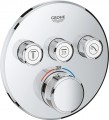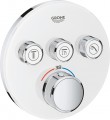Finish
Type of additional finishing provided in the tap. This item can specify several options — this means that this model is available in different design options. And if the finishing material coincides with the body material, this means that there is virtually no additional coating; this is found, in particular, among taps made of stainless steel, which itself is quite resistant to corrosion.
In modern taps, the following types of finishing are used:
granite,
chrome,
chrome with granite,
chrome with gold,
matte chrome, stainless steel (
glossy or
brushed),
brass,
nickel,
copper,
bronze,
gold, as well as
brushed in one color or another. Here are the features of each option:
— Granite. Granite is characterized by a pleasant appearance, moreover, it is available in an abundance of different colours, allowing you to choose a tap for the design of the kitchen. Of its advantages, it is worth noting high durability, absolute resistance to corrosion and good sanitary characteristics (prevents the growth of bacteria). The main disadvantage is the high
...price.
— Chrome. Chrome plating is applied to metal surfaces primarily for corrosion protection; it has a characteristic shiny (almost mirror-like) appearance. Chrome provides high resistance to oxidation and damage, yet looks good and is inexpensive — as a result, it is one of the most widely used coating materials. Its main disadvantage is the tendency to get imprints on it over time; their removal is associated with certain troubles.
— Chrome/granite. The combination of chrome and granite finish in one product. See above for more details about the features of each of these materials, but here we note that their combination implies the presence of different types of finish in different parts of the tap. Thus, the design acquires a more original and stylish appearance, greater hygiene and resistance to contamination than pure chrome, while being cheaper than pure granite. And from the point of view of the overall design of a bathroom or kitchen, it is this combination that in some cases turns out to be the best option.
— Chrome/gold. The combination of chrome finish with individual "gold" sections. The features of chrome are described above, and the "gold" elements give the product a rich appearance, while a fairly large number of buyers prefer this combination to the “solid gold” finish.
— Matte chrome. A matte variation of chrome finish (see above). On such a surface, dirt, and prints are much less noticeable than on a classic glossy; in addition, it may be more suitable in design or simply more pleasing to the eye than glossy. At the same time, the creation of matte surfaces is associated with certain difficulties, and therefore they are relatively uncommon.
— Stainless steel (glossy). Stainless steel finish is generally similar in characteristics to chrome — it is durable and resistant to corrosion. However, such a surface is somewhat different in appearance and for a number of reasons it is used mainly in premium-class models — including taps made entirely of "stainless steel" (such models, in fact, have no finish).
— Stainless steel (brushed). Similar to matte chrome, such steel is more resistant to dirt than glossy (see above), otherwise it is completely identical to it.
— Brass. Brass coating is most often combined with a body made of the same material (that is, there is actually no special finish in such a tap). One of the advantages of such a surface is a pleasant golden hue, which is especially suitable for retro-style taps. At the same time, the cost of such products for a number of reasons turns out to be quite high, besides, they are prone to the appearance of hard-to-remove prints. Therefore, they are quite rare.
— Nickel. In terms of characteristics, nickel finish is similar to chrome and is used for the same purposes, however, for a number of reasons, it is much less common than chrome.
— Copper. Finish of characteristic reddish color. Copper can give an “old” look even to a modern product, and for retro-style taps, it can be simply irreplaceable. On the other hand, this material is expensive, in part because it is difficult for copper to provide sufficient corrosion resistance.
— Bronze. Bronze is an alloy based on the copper described above and is used similarly — mainly to provide an authentic look to retro-style taps. The main difference between the two materials is the color — the bronze is somewhat darker, and the red colour is not as pronounced in it (although specific shades in different models can also be different). In addition, this material is easier to make resistant to corrosion, so bronze products are much more common than copper ones.
— Gold. Yellow alloy finish to imitate the look of gold. It is used to give the tap a rich appearance, while at the same time it is expensive in itself, as a result of which it is used mainly in premium models — in order to emphasize the level of the product even brighter. On the practical side, like any material of this level, it is characterized by high resistance to oxidation, but resistance to pollution and ease of cleaning can be different (although in most cases these indicators are also on top).
— Brushed. A brushed finish that is applied specifically to give the product a certain color — most often black or white, but other options are also found. Accordingly, the main advantage of this option is a non-standard appearance: with paint, you can achieve colors that are not available with other types of finish. At the same time, any paint perfectly resists corrosion, and the differences between different models of taps with such a finish are mainly in durability and scratch resistance. These characteristics, usually, directly depend on the price category of the product.Country of brand origin
Country of origin of the brand under which the tap is marketed. Usually, it is indicated by the "homeland" of the manufacturing company or by the location of its headquarters. The brands under which modern mixers are produced come mainly from the following countries (in alphabetical order):
Austria,
Belgium,
Germany,
India,
Spain,
Italy,
China,
Poland,
Russia,
Turkey,
Czech Republic,
Finland,
France,
Sweden.
There are many stereotypes associated with the “nationality” of brands and products, but most of them have no basis nowadays. First, the actual place of production is often different from the brand's country of origin. Secondly, the quality of the goods depends not so much on geography, but on the policy of a particular company and how carefully this very quality is controlled in it. Therefore, you should pay attention to the country of origin of the brand only if you fundamentally want or (do not want) to support a manufacturer from a certain state. Quality is best judged by the reputation of a particular
...brand and the overall price category of the tap.Manufacturer's warranty
The warranty period claimed by the manufacturer for a certain tap model is the period during which the manufacturer guarantees the normal operation of the device. The specific terms of the warranty may vary, however, usually, it covers factory defects and malfunctions caused by the fault of the manufacturer or seller and discovered during normal use, without violating the rules; if such defects or malfunctions appear during the warranty period, the manufacturer undertakes the obligation to correct the situation at its own expense — up to replacing the tap with a working one.
Nowadays, you can find taps with a guarantee of
4 years,
5 years,
7 years,
10 years and even
25 years. In general, the longer the warranty period, the more reliable the product is, the higher its overall quality, ceteris paribus, but the more expensive it will cost compared to analogues.

